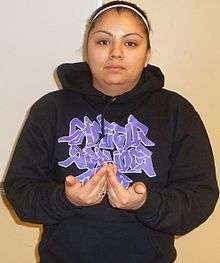BentB@BackFinger-PalmBack-BentB@CenterChesthigh-PalmBack BentB@Ulnar-PalmUp-BentB@CenterChesthigh-PalmUp
American Sign Language
Production
- This two-handed ASL sign is produced as follows:
- Posture the nondominant hand in the “bent B” handshape in front of the center of the chest, nondominant palm facing back. Posture the dominant hand in the “bent B” handshape with the dominant hand at the back of the extended finger(s) of the nondominant hand, dominant palm facing back.

- Move both hands to the following posture by rotating the finger tips upward and the thumbs away from each other.
- Posture the nondominant hand in a relaxed version of the “bent B” handshape in front of the center of the chest, nondominant palm facing up. Posture the dominant hand in a relaxed version of the “bent B” handshape with the dominant hand at the ulnar edge (little-finger side) of the nondominant hand, dominant palm facing up.

- Hold both hands briefly in this posture.
| dominant hand |
type |
hold |
move straight (str) |
hold | |
|
Hand configuration Part of hand
Proximity Part of hand facing |
‘bent B’ (B^u) back of finger (BKFI) back of hand (BK) |
see appendix (B~u) ulnar edge of hand (UL) back of hand (BK) | |||
| nondominant hand |
type |
hold |
move straight (str) |
hold | |
|
Hand configuration Part of hand
Proximity Part of hand facing |
‘bent B’ (B^u) whole hand back of hand (BK) |
see appendix (B~u) whole hand back of hand (BK) | |||
- Stokoe: B⊤B⊤ ɑ
| GUH Hand | LUH Hand | LUH Move | GUH Move | GUH Hand | LUH Hand | ||
|---|---|---|---|---|---|---|---|
| GUH Palm | LUH Palm | Second | Second | GUH Palm | LUH Palm | ||
| GUH Position | LUH Separation | Third | Third | ||||
| bent-B | bent-B | Parallel | Rotate | bent-B | bent-B |  |
 |
| In | In | Up | Up | ||||
| Touching on | |||||||
| LUH Side | |||||||
Adverb

- (interrogative) how
- (rhetorical) how; by; with; using; used to introduce a relative clause that describes the manner of the action of the main clause
- 1@Sternum-FingerBack 1@SideChesthigh-TipFingerUp-1@SideChesthigh-TipFingerUp 1@NearSideChesthigh-TipFingerBack-1@NearSideChesthigh-TipFingerBack C@NearThumb-TipUp-C@NearCenterChesthigh-TipUp C@NearUlnar-PalmBack-C@CenterChesthigh-PalmBack BentB@BackFinger-PalmBack-BentB@CenterChesthigh-PalmBack BentB@Ulnar-PalmUp-BentB@CenterChesthigh-PalmUp B@Side-PalmForward H@Side-PalmForward S@Side-PalmForward
- (ASL gloss) ME COME CLASS HOW? B-U-S
- “I come to class by bus.”
Usage notes
- (interrogative “how?”): In this sense, the sign usually appears at the beginning of a sentence, with the eyebrows furrowed for the duration of the question.
- (rhetorical “how”): In this sense, the sign usually appears at the beginning of the relative clause, with the eyebrows are raised only during this sign. The rest of the clause then either is unmarked with regard to non-manual signals or is marked by a slow, repeating head nod.